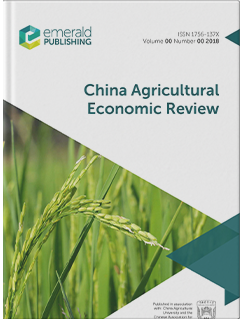Effect of agriculture–tourism integration on in situ urbanization of rural residents: evidence from 1868 counties in China
IF 4.6
2区 经济学
Q1 AGRICULTURAL ECONOMICS & POLICY
引用次数: 0
Abstract
Purpose This study aims to clarify the impact of agriculture–tourism integration (ATI) on in situ urbanization (ISURB) of rural residents, to highlight the role of industrial integration in the process of China's ISURB and to provide industrial integration suggestions for promoting urbanization quality in Chinese counties.Design/methodology/approach By sorting out the panel data of China's 1868 counties, the evaluation index system of ISURB was constructed. Difference in difference (DID) and spatial Durbin-difference in difference (SDM-DID) model is used for estimate the relationship between ATI and ISURB.Findings First, ATI can improve ISURB by 11.4% higher than other regions. Second, theoretical analysis model of ATI on ISURB is constructed from four aspects of “drive–push–pull–block.” The results show that ATI can promote ISURB by increasing upgrading of rural industries, rural employment demand and income capacity, whereas ATI may inhibit ISURB by reducing farmland. Third, considering changes in institutional, hard and soft factors, rural collective economy, information infrastructure and digital finance all promote positive impact of ATI on ISURB. Fourth, ATI will produce spillover effects on ISURB in neighboring regions, which is more pronounced in the central and western regions.Research limitations/implications This study lacks quantification of ATI, so future studies are encouraged to further quantify ATI at the county level.Practical implications This study has policy significance for constructing ATI demonstration counties and promoting ISURB in China's counties.Social implications It is of great practical value to promote China's ISURB. By stimulating ATI, it can improve income and employment capacity of rural residents and stimulate ISURB of China.Originality/value This study enriches the theoretical and practical research on industrial integration behaviors during the process of ISURB.HighlightsUse county data to measure in situ urbanization (ISURB)Agriculture–tourism integration (ATI) can increase ISURBConstructs a “drive-push-pull-block” model to explain the influence mechanismUse spatial Durbin-difference in difference (SDM-DID) modelsConsider collective economy, rural information infrastructure and digital financeGraphical abstract农旅融合对农村居民就地城镇化的影响:来自中国 1868 个县的证据
目的研究农旅融合(ATI)对农村居民就地城镇化(ISURB)的影响,凸显产业融合在中国就地城镇化(ISURB)过程中的作用,为提升中国县域城镇化质量提供产业融合建议。设计/方法/途径通过对中国1868个县的面板数据进行整理,构建ISURB的评价指标体系。采用差分差分(DID)和空间durbin -差分差分(SDM-DID)模型估计ATI与ISURB之间的关系。首先,ATI对ISURB的改善率比其他地区高11.4%。其次,从“驱动-推-拉-块”四个方面构建了ISURB上ATI的理论分析模型。研究结果表明,农业综合整治通过提高农村产业升级、增加农村就业需求和增加农村收入能力来促进农村综合整治,而农业综合整治通过减少耕地面积来抑制农村综合整治。第三,考虑到制度、软硬因素的变化,农村集体经济、信息基础设施和数字金融都促进了ATI对ISURB的积极影响。第四,创新创新会对周边地区的ISURB产生溢出效应,这种溢出效应在中西部地区更为明显。本研究缺乏对ATI的量化,因此鼓励未来的研究进一步量化县一级的ATI。本研究对建设ATI示范县、推进中国县域综合发展具有政策意义。社会启示:推动中国的ISURB发展具有重要的现实价值。通过刺激非农就业,可以提高农村居民的收入和就业能力,从而刺激中国的ISURB。本研究丰富了ISURB过程中产业整合行为的理论和实践研究。亮点用县域数据衡量就地城镇化(ISURB)农业旅游一体化(ATI)能促进就地城镇化(ISURB)构建“驱动-推推-拉-块”模型解释影响机制采用空间Durbin-difference in difference (SDM-DID)模型考虑集体经济、农村信息基础设施和数字金融图形摘要
本文章由计算机程序翻译,如有差异,请以英文原文为准。
求助全文
约1分钟内获得全文
求助全文
来源期刊

China Agricultural Economic Review
AGRICULTURAL ECONOMICS & POLICY-
CiteScore
9.80
自引率
5.90%
发文量
41
审稿时长
>12 weeks
期刊介绍:
Published in association with China Agricultural University and the Chinese Association for Agricultural Economics, China Agricultural Economic Review publishes academic writings by international scholars, and particularly encourages empirical work that can be replicated and extended by others; and research articles that employ econometric and statistical hypothesis testing, optimization and simulation models. The journal aims to publish research which can be applied to China’s agricultural and rural policy-making process, the development of the agricultural economics discipline and to developing countries hoping to learn from China’s agricultural and rural development.
 求助内容:
求助内容: 应助结果提醒方式:
应助结果提醒方式:


